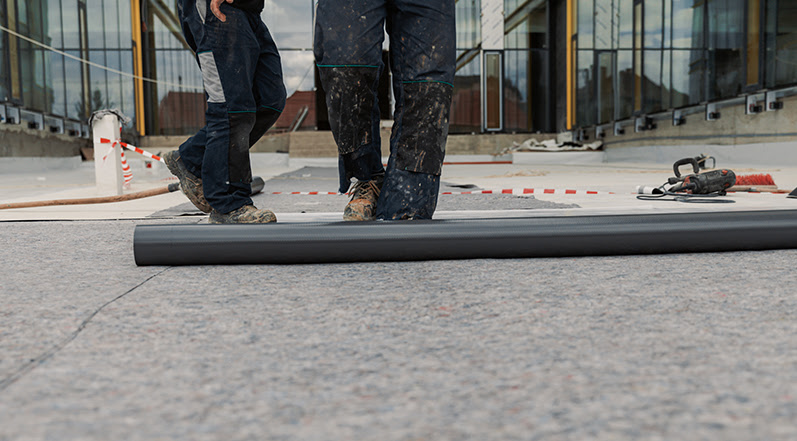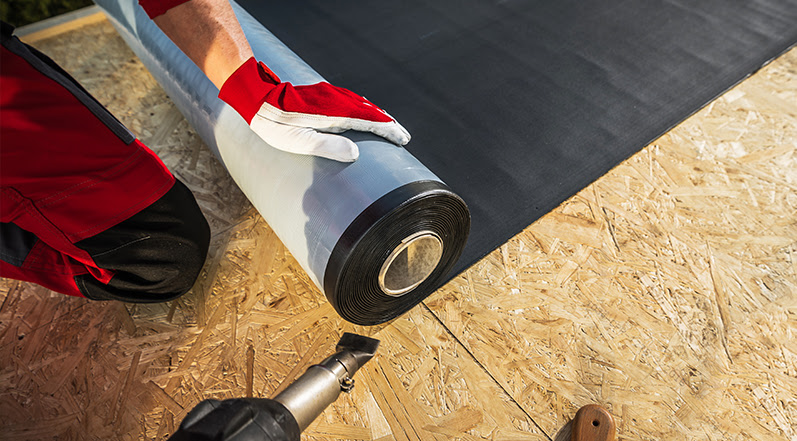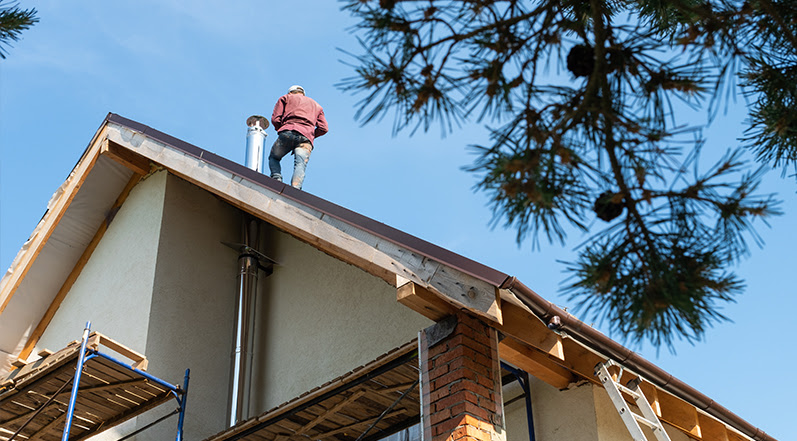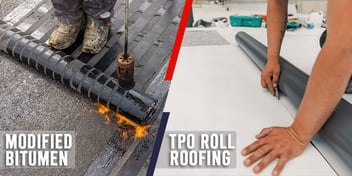- Home »
- Learningcenter »
- Roll roofing guide what
Roll Roofing Guide: What Is It and What Are The Benefits?

Thinking of giving your roof a fresh look or kicking off a small construction project? Roll roofing could be the secret weapon you're looking for. It's budget-friendly and very easy to handle, which makes it a fantastic choice that usually gets ignored.
While it might not be the first thing that comes to mind, roll roofing is a solid choice. Why? Because it's designed with simplicity and flexibility in mind, it's perfect for smaller builds or adding that sleek finish to homes with a gentle slope.
So, why should roll roofing be at the top of your list for your upcoming project? Let's talk about what makes roll roofing so useful and how you can make the most of it for your project. This little guide might just flip the way you think about roofing solutions.
What Is Roll Roofing?
Roll roofing is pretty simple - it's this useful material that comes in rolls, made from mineral-surfaced, oil-based asphalt. Picture this: one roll knocks out about 100 square feet and only weighs around 75 pounds. That makes it way easier to handle than those large traditional asphalt shingles.
What's great is that it's cheaper, and its slim design has more give and take, bending and flexing more easily than shingles could dream of. But it has a catch - it doesn't stick around as long as other parts. So, it's perfect for when you're not looking for a lifetime commitment but need something solid for now.

You'll see it hugging the roofs of smaller places - think of your shed, your busy workshop, or your garage. It's pretty much perfect for roofs that have a bit of a slope to them. Thanks to its go-with-the-flow nature, roll roofing is very easy to slap on.
Deciding if roll roofing is the best option for you means weighing the good with the not-so-good. It won't be a forever roof, but it is another option with a simple yet effective solution for those special kinds of roofing projects. When your project's needs and roll roofing characteristics are a match made in heaven, it makes it a solid choice.
And guess what? Roll roofing isn't a one-trick pony, and it can definitely cater to a handful of roofing needs.
What Are the Different Types of Roll Roofing?
When it comes to roll roofing, you have two main choices: the budget-friendly asphalt roll roofing and the tough-as-nails modified bitumen roll roofing.
Starting with asphalt, this option is pretty amazing if you're working on something smaller, like a garden shed or a cozy workshop. It's easy on your pocket and very easy to install, meaning it's perfect for those who love getting their hands dirty on a project. It comes in loads of colors and styles so you can find the perfect match for your project, and it's great at standing up to whatever the weather throws at it. Just remember, it's best for roofs with a gentle slope.
Then, there's modified bitumen. This type is a real powerhouse in terms of durability: treat it right, and you're looking at over 20 years of reliable service. It's fantastic in colder weather and an expert at keeping water leaks at a distance. Some kinds even bounce back sunlight, which can help keep your energy costs down. Plus, patching up small damages is pretty simple. If you have a flat or nearly flat roof, especially one on a larger building, this is a good option.
Picking between them comes down to your budget, where you live, and the angle of your roof. If you're in the mood for a project and want to keep costs low, asphalt roll roofing is your friend. But for those bigger projects or places needing something super well-built, modified bitumen is another option.

Let's talk about installation.
Laying down-roll roofing is not necessarily rocket science. You start with a clean roof to make sure everything sticks where it should. Then comes a bit of roofing cement to glue everything down snugly. It's important to get that base sheet down flat to avoid any future headaches.
Depending on what you're working with, you might use nails or an adhesive to keep everything in place. Making sure those edges are locked down tight is really important to keep the water out.
Finally, sealing up vents and edges is the last line of defense against water sneaking in. Paying close attention to each step, from cleaning up at the start to those final touches, can make all the difference in keeping your roof in top shape for years.
Why Choose Roll Roofing for Your Project?
Picking the right roof can make or break how your home stands up to the weather. And let's talk about why roll roofing could be a good option for you, especially if your wallet isn't bulging.
It's fantastic for saving dollars both upfront and when you're getting it all setup. When I was fixing up my workshop, roll roofing was a huge help. It goes on quickly and easily.
If you're the type who likes to get your hands dirty with projects, you'll find it's pretty simple to work with. Most of the projects I've used it with have been very simple, which is great for those of us who don't want to fork out loads of cash on labor costs. Whether you're housekeeping a small shed or covering a larger building, roll roofing can usually fit the job.

Talking about toughening up, roll roofing holds its own. Sure, it might not be the Hercules of roofing parts, but with the right care, it stands up to the weather just fine. It's especially useful when you need to whip a roof into shape fast to dodge any incoming bad weather.
Keeping on top of maintenance - like doing regular checks, fixing any issues pronto, and keeping it free from debris - is important to having roll roofing that lasts. The goal is preventing problems before they even think about showing up. Basically, a little effort goes a long way in keeping your roof in great condition.
What Are the Limitations of Roll Roofing?
If you're thinking about giving roll roofing a try for a slightly sloped or almost flat roof, there are a few things you should keep in mind. Steep roofs? Not so much. This type isn't great at handling lots of water rushing down, so it's better for the gentler slopes.
Expect roll roofing to have a shorter lifespan, lasting about 10 to 20 years. That's a bit less than other types of roofing, meaning you'll usually say hello to the roofing crew a bit more.
When it comes to styling, improve your home's look with a mix of colors and styles, and roll roofing might leave you wanting more. Its limited options could make it tough to nail that perfect look or tone you're after, possibly putting a damper on your home's beauty and possibly its value, too.

Also, if you're in a place that gets its fair share of hail or steep winds, roll roofing might not hold up as well. It's a bit on the thinner side, so it's not always the best option for super tough coverage. And, if your roof is a popular hangout spot or path, this type might show wear and tear pretty quickly.
Don't count on roll roofing to be a huge help in the insulation department, either. Looking to cut down on those energy bills or keep your indoor climate just right? You might need to add some additional insulation to the mix.
While it might seem like a piece of cake to lay down roll roofing, getting it just right takes a close eye, especially making sure those seams and edges are snug and secure to keep leaks at a distance. A little slip here could mean a shorter run for your roofing.
So, before getting started, the goal is to balance these downsides with the upsides for your particular project.
How to Install Roll Roofing
Roll roofing installation might look like a giant challenge at first glance, but it's not as tough as it seems. Let's break it down into simpler steps, shall we?
Start with a clean slate. Before anything else, get rid of all the dust and debris chilling on your roof. This step is a cleaning spree; it will make sure that all the layers of your roofing get along, stick together without any fuss, and keep difficult problems at a distance.
Next up, install some roofing cement. Think of it as the glue keeping your roofing game strong. But remember, it's a powerful thing, so a thin, even layer will work well. The goal is to create that waterproof barrier without going overboard.
Then, it's time to roll out the base sheet. Picture it as laying the groundwork for your roof's future. You want it nice and straight, with no bubbles or wrinkles cramping the style. Whether you're team nails or team adhesive, what matters is sticking to the manufacturer's playbook. They wrote it for a reason, and following it is a great way to get a job well done.

Speaking of nailing it, if winds are a regular guest at your place, nailing down the base might be your best move. Keep those nails in line, evenly spaced like soldiers about an arm's length apart or as directed.
Remember to show some love to the vents and edges. Dab some roofing cement around anything that sticks out - vents, pipes, you name it. It's like putting a waterproof jacket around the parts that need it most, which makes sure water stays out.
Rome wasn't built in a day, and good roofing takes time too. Don't rush; those steps are there to guide you towards a roof that won't let you down. But if a DIY job turns into "Uh oh, how do I fix this?", no stress. There's no shame in calling up an expert roofing team. They have the skills to make sure your roof is nothing short of reliable.
Keep in mind that this guide is just the beginning. Depending on the roll roofing dance partner you've chosen, you might need to change your moves a bit. So, keep those instructions useful. They're like your roofing bible, ready to guide you through to salvation.
Maintenance and Longevity Tips
Keeping your roll roofing in great shape is smart; it's really important for making it last longer. Let's talk about how you can stay on top of things without breaking a sweat. Regular check-ups are your assistant here. Giving your roof a once-over at least twice a year, especially when it's raining cats and dogs, can save you from a headache later on. Spot those tiny cracks or anything looking out of place early, and you've just dodged a bullet - big, expensive repairs.
And don't let leaves and twigs throw a party on your roof. Do they make it look messy? They're also a one-way ticket to Mold and Mildew City, which is nowhere you want your roof visited. After a storm, get up there, clean it off, and make sure your gutters are speaking to each other properly. The goal is to make sure water finds its way home without sticking around on your roof.
Make sure your roof's drainage system is buttoned down. Those gutters and downspouts need to be clutter-free so water doesn't get a chance to hang out and cause chaos. And remember, the sun's rays are like kryptonite to your roof's seams and sealants. Slap on a reflective coat to shield it from those UV rays and keep it going strong for years.

It might tempt you to become a weekend warrior and fix roof issues yourself. But some problems are better left to the pros. They have the eyes to catch things we might miss, and let's not forget, staying safe should always be your number one priority. Right gear and knowing what you're getting into is important because rooftops and accidents aren't a good mix.
Following what your roof's manufacturer suggests for care is like following a treasure map. It leads you to the best way to keep things great. While roll roofing might not be the diva of design with its color options, picking the right shade can still make your place look sharp. If you're wrestling with water pooling, think about improving your drainage with extra slopes or drains. Protecting the roof from the sun with regular coatings is like giving it a shield against aging.
Picking roll roofing, especially for those flatter than flat roofs, is a smart move. It's very easy to install and doesn't ask for much. But, like anything worth having, it needs a little work to protect your home over time.
Protect The Roof Over Your Head
Thinking about giving your place a new roof and wondering if roll roofing is the favorite? Well, you're in luck because this thing is easy on the wallet and very easy to put up, especially if you have a building with a low-slope or flat roof. Roll roofing is fantastic for longevity, provided it's set up and cared for properly. But it's good to know it's a bit limited in style and doesn't hang around as long as some other parts. These tidbits are great when deciding what's best for your roofing job.
Deciding on roll roofing? It all comes down to what your project is screaming for, how much you have to spend, and what you see down the road. It pays to mull over any particular hurdles your project might face and go for your parts thoughtfully. Talking about the different roofing options out there can be a great help.

Valuing solid advice and top work is important. Here at Colony Roofers, we're the wizards of both commercial and residential roofing across Georgia, Florida, and Texas, which makes sure you're both safe and smiling with the outcome.
Are you on the fence about which roofing direction you should head in? Speaking with a seasoned roofer is your best bet. We're all set to walk you through your options and help you make the perfect choice.
 Call (678) 365-3138
Call (678) 365-3138



